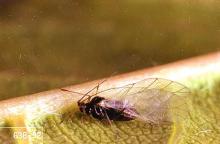Includes black cherry aphid (Myzus cerasi) and rusty plum aphid (Hysteroneura setariae)
See:
Pest description and crop damage Several aphid species attack cherry, including the rusty plum aphid and the black cherry aphid. The aphid feed initially on the shoot tips, which on young trees can cause stunting and malformation of the tips. On older trees, fruit set may be reduced in subsequent years if populations are high. Honeydew production can cause sooty mold problems on fruit.
Biology and life history The aphid overwinter as eggs in crevices and twigs. The eggs hatch near budbreak, and the nymphs feed on unopened buds and the underside of leaves. The leaves curl and protect the aphid as they feed. After two to three generations, winged forms are produced that migrate to summer hosts, which include weeds, ornamental plants, vegetables, or plants of the mustard family (in the case of black cherry aphid). After several more generations, the winged forms migrate back in the fall to the tree fruit to mate, and lay the overwintering eggs.
Scouting and thresholds Begin observing shoots prior to budbreak, as management is best done early and while the aphid are small.
Management-chemical control
See:
Chemical Control of Nursery Pests
Sprays are most effective if applied before leaves curl. It is important to cover foliage thoroughly, including lower leaf surfaces.


